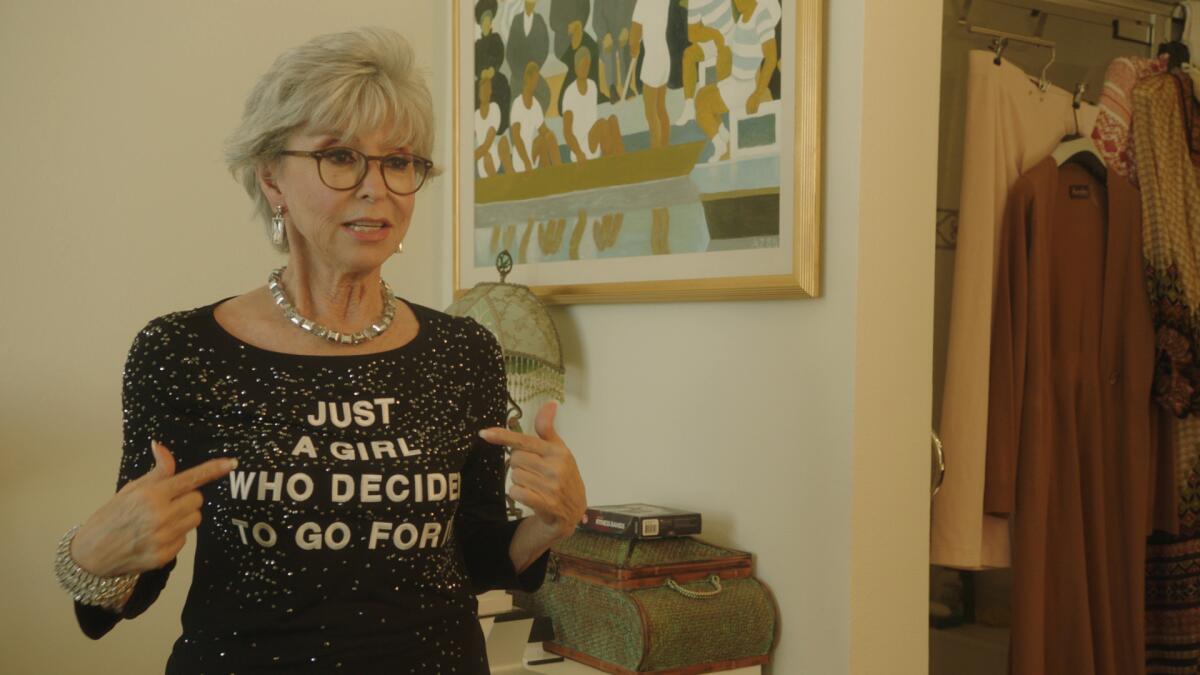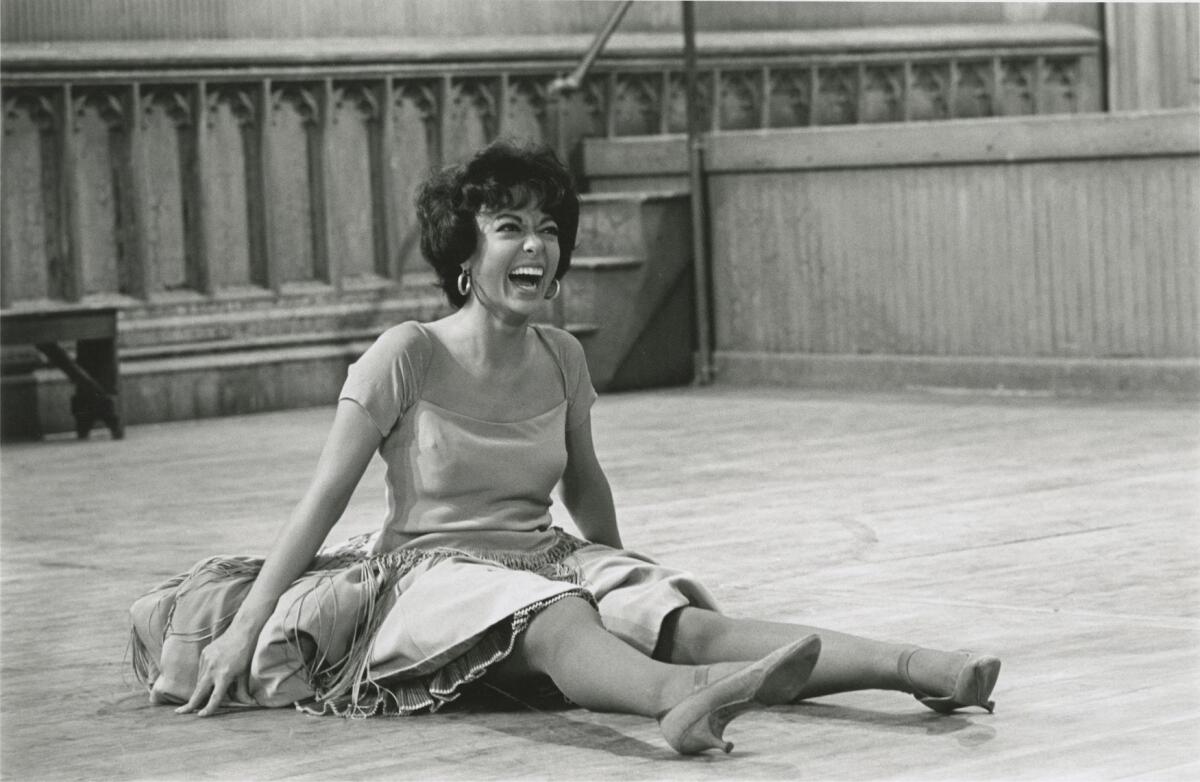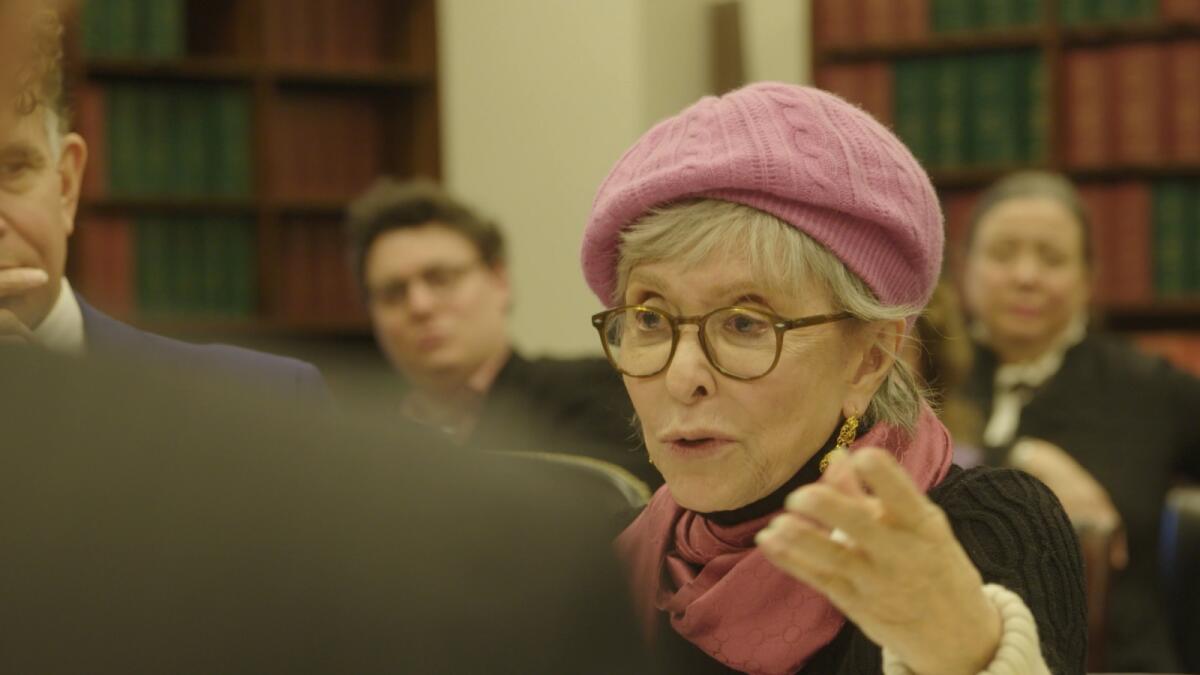Review: Documentary sheds light on Rita Moreno’s career — and recent ‘In the Heights’ remarks

The Times is committed to reviewing theatrical film releases during the COVID-19 pandemic. Because moviegoing carries risks during this time, we remind readers to follow health and safety guidelines as outlined by the Centers for Disease Control and Prevention and local health officials.
Early on in the winsome new documentary about her life and work, Rita Moreno takes gently hilarious aim at Tuptim, the young Burmese concubine she played in the 1956 film of “The King and I.” Wrinkling her nose and tilting her head in a simpering parody of her big romantic number (“We Kiss in a Shadow”), Moreno exercises what feels like a practiced talent for finding the absurdity in a frustrating situation. To become Tuptim and the many other pan-ethnic placeholders she was assigned during her years under studio contract, Moreno had her skin darkened, wrapped her tongue around a thick accent (or amalgam of accents) and tried her hardest to animate a ludicrous stereotype. In her words, “I just tried to do what I could.”
Such were the travails of a future national treasure and Hollywood legend at a time when the industry “didn’t know what to do with a Latina,” as she put it in 2019. With few parts of substance coming her way, Moreno pushed ahead in role after dull, demeaning role, smiling and cajoling and pouting and seducing, getting spanked in “The Vagabond King” and tumbling to her death in “Seven Cities of Gold.” She had a blast as the flashy B-lister Zelda Zanders in “Singin’ in the Rain,” one of the few pictures of the era that didn’t exploit or otherize her. Her breakthrough arrived, of course, with “West Side Story,” the 1961 blockbuster musical that won her an Oscar for best supporting actress, a triumph that came with its own compromises: While Anita remains Moreno’s most memorable big-screen role by far, it was one she still had to play slathered in dark makeup. Being Puerto Rican, apparently, didn’t sufficiently qualify her to play Puerto Rican.
These outrageous recollections, sharply packaged and presented by the director Mariem Pérez Riera, are enough to make “Rita Moreno: Just a Girl Who Decided to Go for It” an eye-opening, rightly infuriating work on its own terms. But I probably wasn’t alone in replaying and rethinking these moments following Moreno’s recent appearance on “The Late Show,” when she defended Lin-Manuel Miranda against criticism of the lack of Afro-Latino lead performers in “In the Heights,” the film version of his Washington Heights-set musical. (Miranda is one of many interviewed in the documentary, which he executive produced.) Moreno’s remarks (“Can’t you just wait a while and leave it alone?”) drew widespread criticism, and within a day she had issued an apology for being “clearly dismissive of black lives that matter in our Latin community.”

There’s an irony in the fact that Moreno, having once presented a darker-complected version of herself to satisfy the racism of 1950s Hollywood, was now being faulted for aligning herself with the colorism of 2020s Hollywood. More irony, perhaps, than surprise: She wouldn’t be the first trailblazer to stand accused of reinforcing the very status quo she battled for most of her career. Whether or not that charge holds water, her comments were illuminating of a larger problem, namely the unfair representational burden shouldered by any major Hollywood production that, like “In the Heights,” is being presented as an overdue corrective. But her remarks were also disappointing in their failure to position Black Latino exclusion on a systemic continuum with her own. One key strand of “Just a Girl Who Decided to Go for It,” focused on Moreno’s long and admirable history of activism on behalf of different marginalized communities, suggests that such parallels are hardly lost on her.
What seems clear from both the “Late Show” incident and (more to the point) this documentary is, for better or worse, Moreno’s apparent guilelessness, her embodiment of what looks and sounds an awful lot like candor. Even in a film that makes no bones about presenting its subject in a flattering, softening light, this 89-year-old stage and screen legend has refreshingly few qualms about saying exactly what she thinks.
She knew she wanted to perform during her early childhood in Humacao, Puerto Rico, a desire that bore fruit after little “Rosita,” as she was nicknamed, moved with her mother to New York City in 1936. The stroke of luck that snagged her a seven-year contract with MGM — she looked like “a Spanish Elizabeth Taylor,” in Louis B. Mayer’s approving words — plunged her into an industry where racism and sexism proved equally rampant. Moreno recounts being propositioned at a party by Harry Cohn, among others, and being raped by her agent — who, to her shame and horror, continued to work as her agent. She also speaks with particular poignancy of the struggles she encountered in her relationships, including a tempestuous affair with Marlon Brando that left her depressed and suicidal. Her 45-year marriage to Leonard Gordon, who died in 2010, was far more stable but also stifling in the long run.

One of the delights of “Just a Girl Who Decided to Go for It” — a subtitle whose explanation perfectly captures her giddy, unpretentious ease in the spotlight — is the sight of Moreno now living and for the most part working as she pleases. The interstitial glimpses of her Bay Area home — whether she’s hanging out with her daughter and grandkids or surrounded by other loved ones at her 87th birthday party — are mostly par for the celebrity-profile course, and no less enjoyable for it. The enormous gallery of friends, colleagues, admirers and scholars called on to extol her legacy include Moreno’s old “Electric Company” collaborator Morgan Freeman and Latino performers like Eva Longoria, Gloria Estefan, Héctor Elizondo and Justina Machado, her co-star on “One Day at a Time.”
That sitcom, whose struggles to survive could furnish their own documentary on Latino representational woes in Hollywood, is held up as a late example of Moreno’s remarkable longevity in an industry that has consistently undervalued her. Even winning an Oscar didn’t open many doors, and her film career stalled for years afterward, forcing her to find and forge new opportunities. She won a Tony for “The Ritz,” a children’s album Grammy for “The Electric Company” and Emmys for “The Muppet Show” and “The Rockford Files.” A long-running role on the HBO series “Oz” brought her fresh acclaim and new audiences. And she’ll be back on the big screen later this year in Steven Spielberg’s remake of “West Side Story,” which, good, bad or in between, will likely stand as a bittersweet marker: a reminder of the gap between the extraordinary career she’s had and the one she was denied.
‘Rita Moreno: Just a Girl Who Decided to Go for It’
Rated: PG-13, for mature thematic content, some strong language including a sexual reference, and suggestive material
Running time: 1 hour, 30 minutes
Playing: Starts June 18 in general release
More to Read
Only good movies
Get the Indie Focus newsletter, Mark Olsen's weekly guide to the world of cinema.
You may occasionally receive promotional content from the Los Angeles Times.








